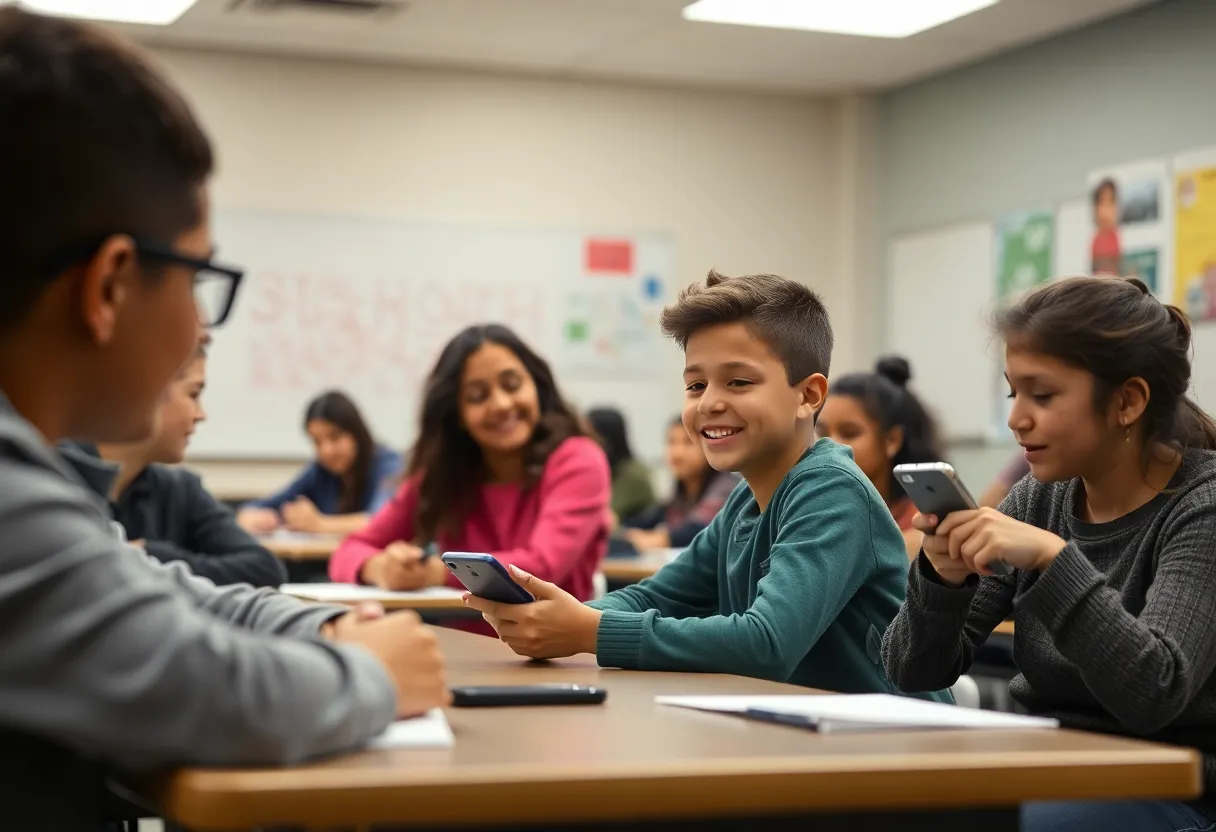Oklahoma City, October 14, 2025
Educators in Oklahoma City are applauding the new cellphone ban in schools, viewing it as a significant policy change that enhances student focus and engagement. The mandate requires mobile devices to be stored out of sight during class, resulting in improved classroom dynamics and academic performance. Teachers report fewer distractions and an increase in productive discussions, especially in middle and high schools. While some students initially resisted, acceptance has grown, fostering better social skills and reducing reliance on digital devices. Data supports the ban’s effectiveness, indicating marked improvements in student participation and test scores.
Oklahoma City Educators Praise Cellphone Ban as Game Changer for Student Focus
Oklahoma City, OK – Educators across Oklahoma City are hailing the state’s new school cellphone ban as a transformative policy that has significantly boosted student focus and engagement since its implementation at the start of the school year. The rule mandates that mobile devices be stored away during class time, leading to noticeable improvements in classroom dynamics and academic performance.
Key Impacts on Classroom Environment
In Oklahoma City Public Schools (OKCPS), the policy requires students to keep their phones out of sight using methods like pouches or lockers. Teachers have observed fewer distractions during lessons, resulting in more productive classroom discussions. This effect has been especially pronounced in middle and high schools, where student engagement has increased as attention shifts from screens to interactive learning. One principal noted the ban’s role in enhancing overall academic outcomes, describing it as a pivotal shift for student success.
Student Adaptation and Social Benefits
Initial resistance from some students has given way to broader acceptance, as shown in recent surveys tracking adaptation rates. The policy emphasizes developing social skills through offline interactions, encouraging face-to-face communication among peers. By limiting device use, schools aim to foster deeper connections and reduce reliance on digital distractions, which educators believe contributes to a healthier learning environment.
Statewide Data and Pilot Results
Supporting evidence from statewide data indicates substantial gains, with pilot districts reporting up to 20% improvements in test scores following similar implementations. These results highlight the ban’s potential to elevate educational standards across Oklahoma, providing a model for other regions. In Oklahoma City, the policy aligns with these findings, as local schools continue to see positive trends in student participation and concentration levels.
Challenges and Policy Refinements
Not all feedback is unanimous. Critics point out the need for balanced access to technology, arguing that devices can aid learning when used appropriately for educational purposes. In response, district officials are adjusting the policy to allow supervised use of phones for specific apps and tools that support instruction. This balanced approach seeks to maintain the ban’s benefits while addressing concerns about equitable tech integration.
Ongoing Monitoring and Teacher Support
As the semester advances, Oklahoma City schools are closely monitoring the policy’s outcomes to fine-tune enforcement strategies. This includes investing in teacher training to ensure consistent application across classrooms. The goal is to maximize the ban’s advantages, such as reduced disruptions and heightened focus, while minimizing any unintended hurdles for students and staff. Early indicators suggest the policy is meeting its objectives, with educators optimistic about long-term gains in student achievement.
The cellphone ban represents a deliberate effort by Oklahoma’s education system to prioritize undivided attention in learning spaces. By creating device-free zones during instruction, schools are witnessing a return to core educational practices that emphasize active participation. As implementation matures, the focus remains on gathering data to inform future adjustments, ensuring the policy evolves to meet the needs of a diverse student body.
Overall, the transition to a less distracted classroom has been smoother than anticipated, with many stakeholders recognizing its value in cultivating a more immersive learning experience. This initiative underscores a broader commitment to adapting educational environments to contemporary challenges, positioning Oklahoma City schools for sustained progress.
In the coming weeks, district leaders plan to review feedback from teachers and students to assess the policy’s effectiveness further. Such evaluations will help refine guidelines, potentially incorporating flexible options for technology use in non-instructional periods. The emphasis on empirical outcomes ensures that decisions are data-driven, benefiting the entire educational community.
This development comes amid ongoing discussions about technology’s role in education. While the ban addresses immediate concerns like divided attention, it also prompts reflection on integrating digital tools thoughtfully. Oklahoma City’s experience with the policy offers insights that could influence similar efforts elsewhere, highlighting the importance of responsive educational reforms.
(Word count: 612)
FAQ
What is the new school cellphone ban in Oklahoma City?
The new school cellphone ban requires devices to be stored away during class time in Oklahoma City Public Schools (OKCPS).
When was the cellphone ban implemented?
The cellphone ban was implemented at the start of the school year.
How are schools enforcing the ban?
Many OKCPS schools are using pouches or lockers for compliance with the cellphone ban.
What positive effects have teachers reported?
Teachers report fewer distractions and improved classroom discussions, particularly in middle and high schools.
How has the ban impacted student adaptation?
Surveys show growing adaptation among students, with emphasis on building social skills offline.
What does statewide data show about the ban?
Statewide data supports the ban, showing up to 20% gains in test scores in pilot districts.
What are the criticisms of the policy?
Critics argue for balanced access to tech for learning.
How are district officials responding to criticisms?
District officials are refining the policy to include supervised use for educational apps.
What is happening as the semester progresses?
OKC schools are monitoring outcomes to refine enforcement and support teacher training.
Key Features of Oklahoma City’s School Cellphone Ban
| Feature | Description |
|---|---|
| Implementation Date | At the start of the school year |
| Enforcement Method | Devices stored in pouches or lockers during class time |
| Reported Benefits | Fewer distractions, improved discussions, especially in middle and high schools |
| Student Impact | Growing adaptation, focus on offline social skills |
| Supporting Data | Up to 20% gains in test scores in pilot districts |
| Policy Adjustments | Supervised use for educational apps; ongoing monitoring for enforcement and training |
Deeper Dive: News & Info About This Topic
HERE Resources
Oklahoma City Launches Youth Safety Advisory Committee to Combat Rising Youth Violence
Oklahoma City Lawmakers Study Classroom Technology Use
Oklahoma City Educators Praise Cellphone Ban as Game Changer in Classrooms





